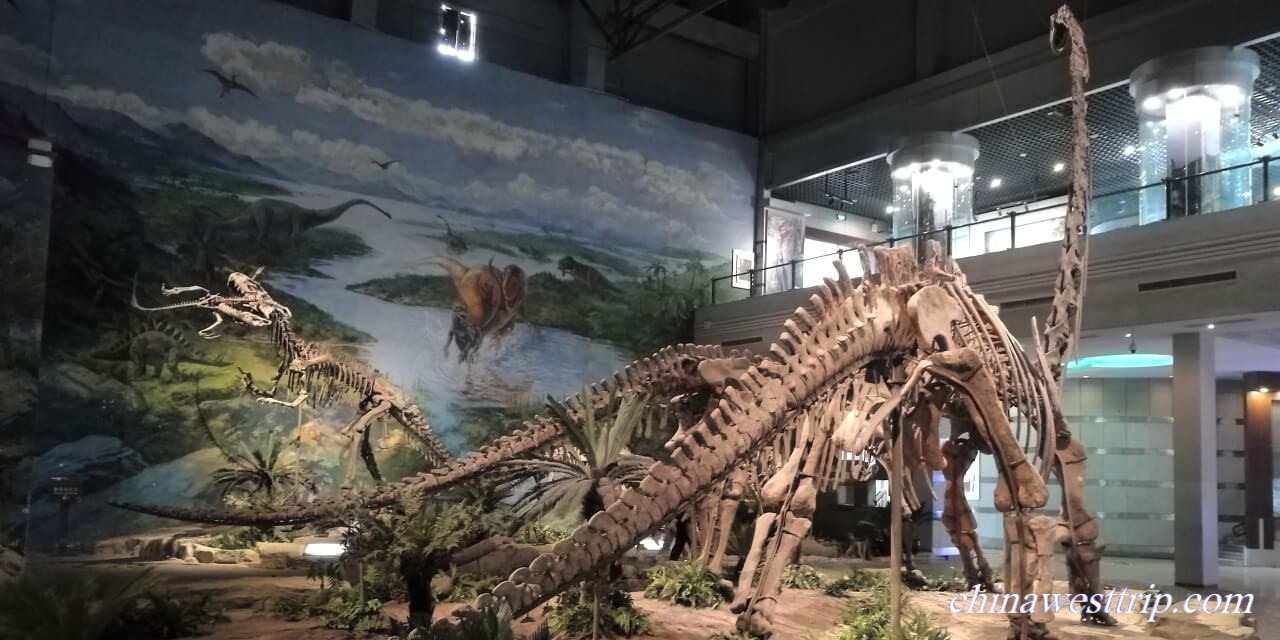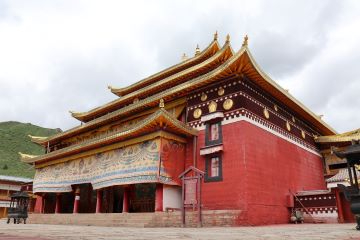Zigong Dinosaur Museum

Name in Chinese: 自贡恐龙博物馆 Zì Gòng Kǒng Lóng Bó Wù Guǎn [dzi’gɔ:n kɔ:nlɔ:n bɔ: wu: gwæ]
Duration of Tour: One and a Half Hours
Location: No.268, the Fourth Section of Shenhaijin Road, Da’an District, Zigong Prefecture, Sichuan Province
Highlights: the Exhibition of Dinosaur Fossils
Reputations: One of the Three On-the-site Dinosaur Museums in the World, A National Geological Park, A National Four-star Scenic Area, One of China’s Top-class Museums
Zigong Dinosaur Museum is also known as Zigong National Geological Park. The National Geographic of USA reports it as the best of all dinosaur museums in the world. The museum is situated at Dashanpu Town, approximately 9 km(5.6 miles) away from downtown Zigong. It was built on the excavation site in 1984 and opened to the public in 1987. The excavation site is called Dashanpu and well-known as “the Dinosaur Cemetery”. In 1915, an American geologist, George D. Louderback was invited by Chinese government to explore natural gas resource in Zigong Prefecture. On August 30th, the geologist came across two pieces of dinosaur fossils, when he led his team to Rongxian County for his exploration. One is a tooth and the other one is a part of femur. In 1972, the Dinosaur Cemetery was discovered. The excavation started in 1977. In the following seven years, over 100,000 pieces of dinosaur fossils were unearthed from the Dashanpu Site.
The museum covers an area of 7 hectares(17 acres). It comprises four parts, namely, the Lobby, the Exhibition Hall of Fauna and Flora in the Jurassic, the Exhibition Hall of Specimen, and the Excavation Site of Dinosaur Cemetery.
The Lobby
Visitors can broaden their knowledge about dinosaurs at the lobby through the descriptions and illustrations. The term-----dinosaur was coined by Richard Owen, a British biologist. It means terrifying lizard in English. During the Triassic Age around 230 million years ago, the earliest dinosaurs evolved from a species which has been known as the thecodonts. The formation of pelvis is utilized to categorize dinosaurs by biologists. The dinosaurs are classified into two distinctive groups, namely the Bird-hipped ornithischuia and the Lizard-hipped Saurischia. With its strong adaptability to the environment, the dinosaurs thrived during the late Jurassic Period and the Cretaceous Period. However, such a powerful creature which dominated the earth for 100 million years mysteriously vanished by the end of the Cretaceous Period, some 67 million years ago. What caused the extinction of dinosaurs? The biologists concluded various controversial theories, such as “the Climate Change Theory”, “the Asteroid Collision Theory”, “the Alkaloid Poisoning Theory” and “the Sudden Genetic Change Theory”.
As a specialized institution, Zigong Dinosaur Museum focuses on popularizing the knowledge about dinosaurs and related science. An electronic map displays the distribution of dinosaur fossils in the world as well as the periods when those dinosaurs were living. There is also a bar graph at the lobby. It shows all the details about the dinosaur fossils unearthed in Zigong Prefecture since 1915.
The Exhibition Hall of Fauna and Flora in the Jurassic
It displays a collection of the creatures and plants which existed together with the dinosaurs. While the blue planet was occupied by the extinct dinosaurs, pterosaurs( or flying reptiles) and pliosaurs(or marine reptiles), other creatures also thrived on the earth, such as turtles, crocodiles, and mammals. The dominating plants in the Dinosaur Age were the tall arbors and short pteridophytes(or nonflowering plants), like ginkgo and sago cycas.
The Exhibition Hall of Specimen
A global marine regression occurred in the early Jurassic Period. It resulted in a deficiency of the foreland-facies sedimentary formation during the early-mid Jurassic Period. Before the worldwide renowned Zigong Dinosaur Cemetery was excavated, there was a lack of dinosaur fossil discovery related with this period. Fortunately, the discovery at the Dinosaur Cemetery completed the chain of its evolution. The biologists highly rated it as the greatest discovery of dinosaur fossils in the 20th century. Some typical dinosaur fossils excavated at the site are listed in the following:
Omeisaurus Tianfuensis
Size: 2,000×150×1,000 cm (65.6×5×32.8 feet)
Period of Existence: the Middle Jurassic
Omeisaurus Tianfuensis belongs to the family of well-developed lizard-footed dinosaurs. It is quite large in size, with its big head, long neck, spoon-like teeth and strong limbs. Its skeleton is 20 meters long and 3 meters high from its limbs to its back. The biologists concluded that the weight of Omeisaurus Tianfuensis might reach 40 tons when it was alive. Omeisaurus Tianfuensis mainly inhabited by inland lakes, eating algae and other plants. They habitually hide themselves in water and stuck their heads out of the water watching for the predators.
Shunosaurus Lii
Size: 1200×140×350 cm (39×4.6×11 feet)
Period of existence: the Middle Jurassic
As a member of the primitive lizard-footed dinosaur family, Shunosaurus Lii has a medium-sized head, a short neck, spoon-shaped teeth, prominent hind legs, and short undeveloped forelimbs. Features of both the primitive lizard-footed dinosaurs and developed lizard-footed dinosaurs can be found from Shunosaurus Lii. It is a herbivorous dinosaur, living on marshes by rivers and lakes.
Shunosaurus Lii
Size: 1200×140×350 cm (39×4.6×11 feet)
Period of existence: the Middle Jurassic
As a member of the primitive lizard-footed dinosaur family, Shunosaurus Lii has a medium-sized head, a short neck, spoon-shaped teeth, prominent hind legs, and short undeveloped forelimbs. Features of both the primitive lizard-footed dinosaurs and developed lizard-footed dinosaurs can be found from Shunosaurus Lii. It is a herbivorous dinosaur, living on marshes by rivers and lakes.
Huayangosaurus Taibaii
Size: 430×100×140 cm (14×3.28×4.6 feet)
Period of existence: the Middle Jurassic
Featured by its small head and two symmetrical rows of spikes along its back, Huayangosaurus Taibaii appears to be an early type of stegosaurus. It is a small or medium sized dinosaur with a thorn-shaped tail and small leaf-like teeth. There are two pairs of thorns on its tail. The tail served as a weapon for self-defence.
Gasosaurus Constrictus
Size: 400×100×250 cm (13×3.3×8 feet)
Period of existence: the Middle Jurassic
Gasosaurus Constrictus is a very early carnivorous saurischian(or theropod). The carnivorous saurischian eventually evolved into the familiar Tyrannosaurus in the Cretaceous Period. Gasosaurus Constrictus has a three-pronged pelvis and strong hind legs. The strong hind legs enabled it to run fast for chasing its prey. As soon as the prey was captured, the dinosaur swiftly tore the prey apart with its dagger-like teeth. Its well-evolved skull and powerful musculature enabled the dinosaur to generate effective bite force.
Yandusaurus Multidens
Size: 140×40×70 cm (4.6×1.3×2.3 feet)
Period of existence: the Middle Jurassic
Yandusaurus Multidens is a small-sized omnivorous dinosaur. It has a short mouth with many small needle-like teeth, a small head with relatively large round eyes, short front legs and slender hind legs. All of its features indicate that Yandusaurus Multidens was a good runner who lived in shrubs, eating plants, mammals, lizards and insects.
Angustinaripterus Longicephalus
Size: 100 cm long, a 3-meter wingspan, and 5 kg in weight
Period of existence: the Middle Jurassic
Angustinaripterus Longicephalus was not good at flying due to its underdeveloped breast musculature. Gliding was the main way for it to move around. It soared over water catching fish.
Pliosauridae
Pliosauridae is a marine dinosaur. It has a flat body with four oar-like limbs. As a carnivore, Pliosauridae was the king under water.
The Dinosaur Cemetery
The Dinosaur Cemetery covers an area of 1.7 hectares(4.2 acres). The excavation site is 1,350 square meters(14,531 sq.ft) in area, consisting of two parts, the north section and the south section. It displays 40 skeletons of dinosaurs.
How to Get to Zigong Dinosaur Museum
The dinosaur museum is located in Da’an District, Zigong Prefecture. The distance between Zigong and Chengdu is about 180 km(112 miles). It takes around two and a half hours to get to the museum from Chengdu.
Opening Hours:
8:30 A.M.---5:30 A.M.
Related Articles:
Zigong Travel Guide
Zigong Salt Museum
Author: Tina Luo
Update:
